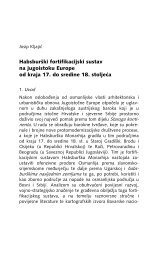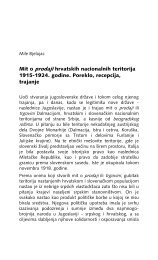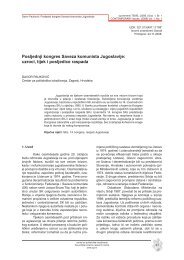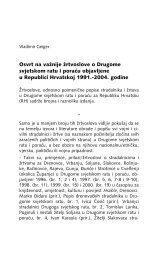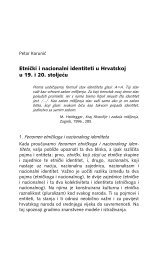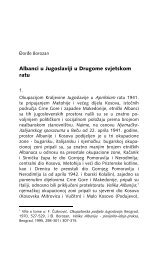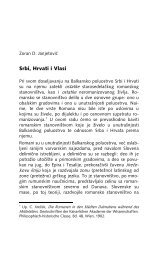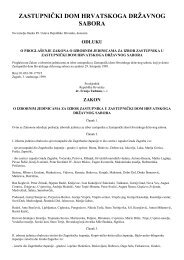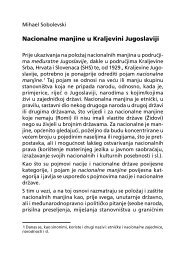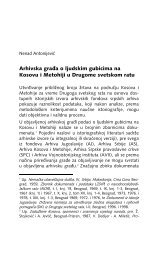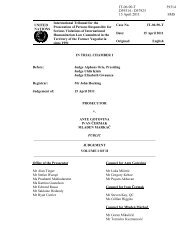ISSN 1847-2397 godište II broj 1 2009. | volume II number 1 2009
ISSN 1847-2397 godište II broj 1 2009. | volume II number 1 2009
ISSN 1847-2397 godište II broj 1 2009. | volume II number 1 2009
- No tags were found...
You also want an ePaper? Increase the reach of your titles
YUMPU automatically turns print PDFs into web optimized ePapers that Google loves.
Plamena Pehlivanova: The Decline of Trust in Post-Communist Societiessuvremene TEME, (<strong><strong>2009</strong>.</strong>) God. 2, Br. 1CONTEMPORARY issues, (<strong>2009</strong>) Vol. 2, No. 1had not much of a choice but to reside with theirparents. Important is to consider the ecologydependentmechanism, which the communalapartments (komunalki) introduced towards thepattern of family life. From the Communal Livingin Russia Project we are able to grasp theatmosphere of the interior structure of the komunalki,and to also read primary documentswritten by members of these social/family structures.There are many reasons why people livedin communal apartments in the Soviet period,and why many continued to live in them after thecollapse. From a simple historical view, the severeshortages of housing explain the existencein these komunalki (in Bulgaria and Russia) duringthe entire USSR. The ideology behind thismass phenomenon came from the state’s communistphilosophy of “communal lifestyle”. Afterthe collapse, many unmarried, divorced or widowedwomen remained living in them, becauseof the inability to improve their standard of livingand the decline in their pensions/incomes.“Unless they have cash income apart from theirprimary salaries, personnel in education, healthcare, the sciences, civil administration, and otherpublic sectors earn less than the average monthlysalary (as of 2006, 9900 rubles per month orapproximately $343, according to the RussianFederal State Statistics Service)” (Buckley, Gurenko,1997: 1).In Bulgaria (1990), the Country StudiesSeries by the Federal Research Divisionof the Library of Congress reports: 65% of thepopulation averaged only half a room per familymember. Only 36% of families with childrenunder eighteen had a separate children’s room;65% used the living room as a bedroom; and57 % used the kitchen as a bedroom. By 1990communal apartments were becoming rarer,however; at that time, 12 percent of familiesshared a kitchen with another family (NationsEncyclopedia, 1992). The Country Studies alsoreport that 60 % of the younger generation wasforced to stay in their parents’ homes after marriage.In 1990 over 40 % of homes included twoor more families or other relatives of one family.Members of three or even four generations oftenlived together. Traditional acceptance of theextended family contributed to this situation, butlong waits for separate housing also played acritical role. In 1979 the government establisheda special Young Newlywed Families Fund thatensured that new families would receive at least25 % of new government housing. This programdelivered more housing to young families in the1980s, but waiting lists also grew longer duringthat period.The relationship between housing andpatterns of household formation proves to bemuch emphasized in the 1990s because of constructionstandstill in both countries. The 2002census outcomes also reflect the emergenceof a phenomenon relatively new to the Russianand Bulgaria society — young urban professionalsleaving the parental home before marriageand setting up one-person households in rentedor purchased apartments (Afontsev, 2008:178). The modernization tendencies enforce ofthe emergence of a contingent of young urbanprofessionals who set up a separate householdbefore marriage. Nevertheless, social and economicinstability in these two countries continuesto strengthen the institute of family as anincome-pooling unit, including the traditional extendedfamily household. Because of the economicinstability and the transitional processesthat are still underway, it cannot yet be predicted,which of these trends will eventually prevail.In these terms, the family remains astrong institution which has traditionally formedthe moral values and cultural patterns in bothBulgaria and Russia. As Inglehart has noted,some post materialistic values have had animpact on the younger Bulgarian generation –autonomy, postponing marriage and increasedmobility (Inglehart, 1997: 132). However, healso claims that empirical evidence is still limitedand not representative to predict the developmentof the activist role of the family in relationto affirmation of the democratic values (Georgiev,2007: 121). In addition, the Bulgarian andRussian family structure cannot yet be definedas “slim”, as mentioned by Clark’s model in TheNew Political Culture (Clark, Hoffmann-Martinot,1998). Even though not slim, the contemporaryBulgarian family is to be characterized with higheducational homogeneity, says Plamen Georgiev.(Georgiev, 2007: 120). As previously noted,Terry Clark’s model suggests that higher educationand slimmer family lead to the increase inindividual and group tolerance (Clark, Hoffmann-Martinot, 1998). However, the two influential factorsare not fully expressed in the Bulgarian case.The educational level seems relatively high butthe family has not evolved to answer the categoryof “slim”. As a result, though, Georgiev furthernotes that the Bulgarian society reports a steadyethnic tolerance, especially concerning religion.The Ottoman occupation and the WW<strong>II</strong> Jewishimmigrant population in Bulgaria have resultedin gradual increase in ethnic tolerance. Therefore,the Bulgarian social mechanism doesn’tcentar za politološka istraživanjathe political science research centrewww.cpi.hr44



